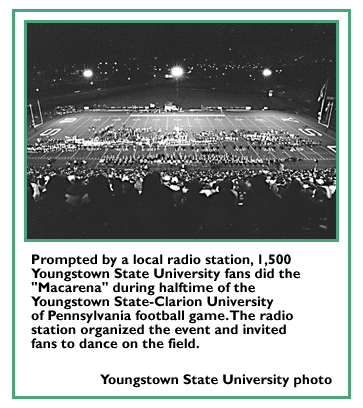The NCAA News - Briefly in the News
November 4, 1996

Fans in Montana put rivalry aside
Sportsmanship and compassion may be ailing these days, but they are not dead.
Ron Loghry, assistant commissioner of the Big Sky Conference, reports on a recent development in Montana.
Marcus Jackson, an all-America defensive back for Idaho State University, sustained a catastrophic neck injury in a game against Western Montana College that has left him paralyzed from the shoulders down.
Idaho State played a Big Sky game at Montana State University-Bozeman the next week, and on the day of the game the Idaho State athletics department set out to sell "Remember Marcus" pins with his number 28 on them to Idaho State fans in the parking lot (the pins had been printed too late to sell in Pocatello before the game).
Loghry said that Montana State fans saw what was happening and took part in a way that reflects what's good about sports -- and people in general.
In a letter to the editor of the Bozeman Daily Chronicle, Idaho State sports information director Glenn Alford wrote:
"The Idaho State University Athletic Department is very much indebted to the magnificent fans of the Montana State football team. You know who you are, and you're very special people.
"You are the people who paid as much as $100 for the Marcus Jackson pins that the ISU Bengal Foundation was selling to raise funds for some of Marcus' immediate financial concerns following his tragic injury.
"Some of the foundation members hit on the idea of selling the buttons to ISU fans for $5 each to raise money for the Marcus Jackson Special Assistance Fund. The buttons arrived late Friday, and the ISU booster bus for the Saturday, September 28, game left early Saturday morning, so the only ones sold before the bus arrived in Bozeman were sold to people on the bus, not the general public.
"Foundation Executive Director Steve Hayes figures about $200 worth of buttons were sold to Idaho State people on the bus. But button sales generated some $1,400 in revenue.
"Simple subtraction tells us that MSU people bought $1,200 worth of the buttons. Some MSU people who bought buttons then sold them to their friends and gave the money back to the Bengal Foundation. Steve says some buttons were sold three or four times, always with the money reverting to the Bengal Foundation for Marcus' fund.
"Frankly, you people ran us out of buttons. We had to order more for our fans. We're glad to do it. Thank you very much, Montana State football fans."

Dancing Penguins
Where can you find 1,500 Penguins doing the "Macarena" at once? Antarctica might be one option, and while it's possible that the ubiquitous dance has reached that far, it would be easier to view the phenomenon at Youngstown State University, where 1,500 Penguin fans recently took the field for a mass rendition.
A local radio station organized the event, in which fans were invited to dance on the field during halftime of the Youngstown State-Clarion University of Pennsylvania game.
"It's a great feeling when people ranging in age from elementary-school children to grown-up adults take part," said Kelly Stevens, a disc jockey for the radio station that helped organize the event.
The great feeling continued for Youngstown State, which won the game, 51-10.

Robbing the cradle
What this proves isn't exactly for sure, but the sports information office at the University of Akron recently determined the youngest football coaching staffs in Division I-A (the average age is based on 10 coaches, excluding graduate assistants, volunteer assistants and/or student assistants):
Institution -- Avg. Age
1. Ohio -- 35.3
2. California -- 35.5
3. Bowling Green -- 35.7
4. Louisville -- 35.9
5.Arkansas State -- 36.1
6.UNLV -- 36.5
7.Cincinnati -- 36.7
Mississippi -- 36.7
9.Ball State -- 37.0
Baylor -- 37.0
11. Akron -- 37.1
Eastern Michigan -- 37.1
13. Navy -- 37.5
14. Tulsa -- 37.6
15. New Mexico -- 37.7
-- Compiled by David Pickle

Looking back
5 years ago: The NCAA asks a U.S. District Court to set aside a Nevada law that is preventing the Association from completing an infractions case involving the University of Nevada, Las Vegas. In a suit filed November 12, 1991, the Association asks for relief from the state law that compels the NCAA to meet a variety of unattainable due process requirements in pursuing infractions cases in that state and provides for extreme monetary damages if the NCAA is found to have violated the statute. The action involves an infractions case that began in 1987, when the university and the Pacific Coast Athletic Conference (now the Big West Conference) investigated alleged violations of NCAA rules in Nevada-Las Vegas' recruitment of Lloyd Daniels. (The NCAA News, November 18, 1991)
10 years ago: The NCAA Administrative Committee approves the implementation of an eight-team, two-division bracket for the College World Series, effective in 1988. The new format mostly preserves the double-elimination system that has been used during most of the Division I baseball tournament's history, but it allows the championship game to be scheduled on a predetermined date. The move is expected to result in coverage of the championship game by a major television network. The eight-team format replaces a four-team, single-elimination format that was approved earlier in 1986 but attracted opposition from coaches, athletics directors and conference commissioners. (The NCAA News, November 10, 1986)
15 years ago: The NCAA Division I Men's Basketball Committee recommends to the NCAA Executive Committee that no more than 40 percent of the Division I Men's Basketball Championship's bracket be allocated to conference champions. The committee also recommends that automatic-qualification conferences be determined strictly by the NCAA Ratings Percentage Index. If adopted, the recommendation would limit the number of automatic qualifiers in the 48-team Division I championship to 20. (NCAA News, November 15, 1981)
|